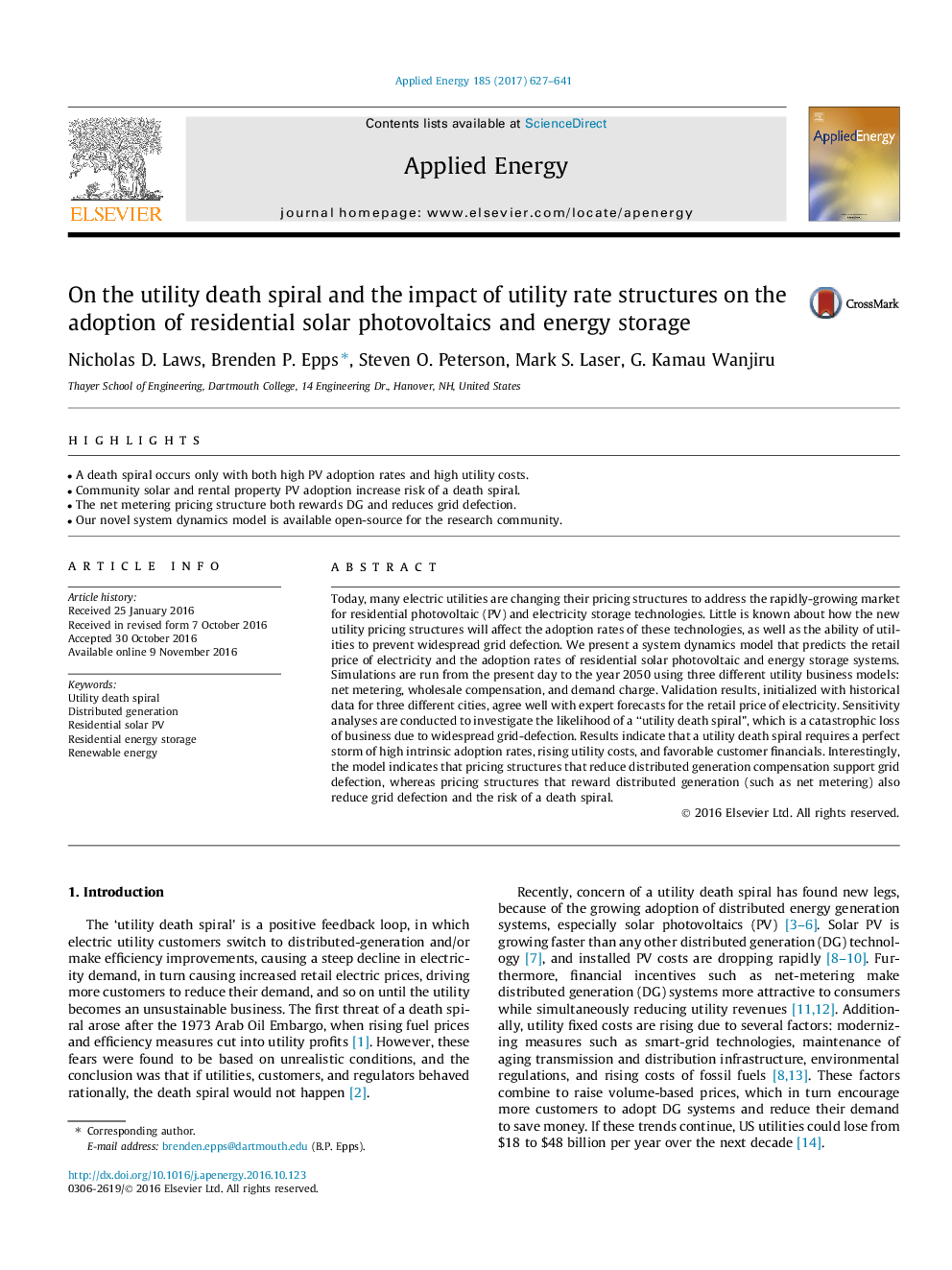| کد مقاله | کد نشریه | سال انتشار | مقاله انگلیسی | نسخه تمام متن |
|---|---|---|---|---|
| 4917001 | 1362738 | 2017 | 15 صفحه PDF | دانلود رایگان |
عنوان انگلیسی مقاله ISI
On the utility death spiral and the impact of utility rate structures on the adoption of residential solar photovoltaics and energy storage
ترجمه فارسی عنوان
در مورد مارپیچ مرگ ابزار و تاثیر ساختارهای نرخ بهره بر روی تصویب فتوولتائیک خورشیدی مسکونی و ذخیره انرژی
دانلود مقاله + سفارش ترجمه
دانلود مقاله ISI انگلیسی
رایگان برای ایرانیان
کلمات کلیدی
ترجمه چکیده
امروزه بسیاری از تاسیسات برق در حال تغییر ساختارهای قیمت گذاری خود هستند تا به بازار فاکتورهای فتوولتائیک (فتوولتائیک) و فضای ذخیره سازی که در حال رشد است، توجه کنند. در مورد چگونگی ساختارهای جدید قیمت گذاری ابزارها بر میزان پذیرش این فن آوری ها، و همچنین توانایی خدمات آب و برق برای جلوگیری از تخریب گسترده شبکه، شناخته شده نیست. ما یک مدل پویایی سیستم ارائه می دهیم که قیمت خرده فروشی برق و نرخ پذیرش سیستم های فتوولتائیک و ذخیره انرژی خانگی را پیش بینی می کند. شبیه سازی ها از امروز تا سال 2050 با استفاده از سه مدل کسب و کارهای مختلفی نظیر اندازه گیری خالص، غرامت عمده و هزینه تقاضا انجام می شود. نتایج اعتبار سنجی، با داده های تاریخی برای سه شهر مختلف، با نتایج پیش بینی شده برای قیمت خرده فروشی برق، موافق هستند. تجزیه و تحلیل حساسیت به منظور بررسی احتمال پیروی از مرگ و میر ناشی از مرگ و میر ناشی از فقدان فاجعه آمیز کسب و کار به دلیل گسترده شدن شبکه، انجام شده است. نتایج نشان می دهد که یک مارپیچ مرگ ابزار نیاز به یک طوفان کامل از نرخ پذیرش ذاتی بالا، افزایش هزینه های ابزار و مشتریان و مشتریان مطلوب دارد. جالب توجه است که این مدل نشان می دهد که ساختارهای قیمت گذاری که کاهش تولید توزیع شده را کاهش می دهند، حمایت از شبکه را تخریب می کنند، در حالیکه ساختارهای قیمت گذاری که پاداش تولید توزیع شده (مانند اندازه گیری خالص) را نیز کاهش می دهند، کاهش شبکه و خطر مارپیچ مرگ را کاهش می دهد.
موضوعات مرتبط
مهندسی و علوم پایه
مهندسی انرژی
مهندسی انرژی و فناوری های برق
چکیده انگلیسی
Today, many electric utilities are changing their pricing structures to address the rapidly-growing market for residential photovoltaic (PV) and electricity storage technologies. Little is known about how the new utility pricing structures will affect the adoption rates of these technologies, as well as the ability of utilities to prevent widespread grid defection. We present a system dynamics model that predicts the retail price of electricity and the adoption rates of residential solar photovoltaic and energy storage systems. Simulations are run from the present day to the year 2050 using three different utility business models: net metering, wholesale compensation, and demand charge. Validation results, initialized with historical data for three different cities, agree well with expert forecasts for the retail price of electricity. Sensitivity analyses are conducted to investigate the likelihood of a “utility death spiral”, which is a catastrophic loss of business due to widespread grid-defection. Results indicate that a utility death spiral requires a perfect storm of high intrinsic adoption rates, rising utility costs, and favorable customer financials. Interestingly, the model indicates that pricing structures that reduce distributed generation compensation support grid defection, whereas pricing structures that reward distributed generation (such as net metering) also reduce grid defection and the risk of a death spiral.
ناشر
Database: Elsevier - ScienceDirect (ساینس دایرکت)
Journal: Applied Energy - Volume 185, Part 1, 1 January 2017, Pages 627-641
Journal: Applied Energy - Volume 185, Part 1, 1 January 2017, Pages 627-641
نویسندگان
Nicholas D. Laws, Brenden P. Epps, Steven O. Peterson, Mark S. Laser, G. Kamau Wanjiru,
